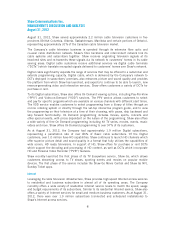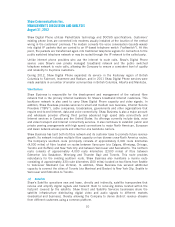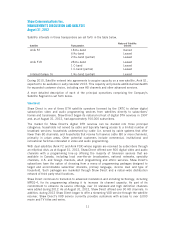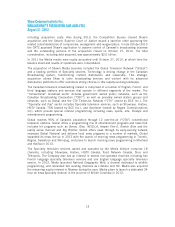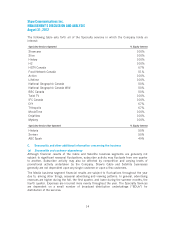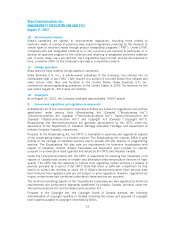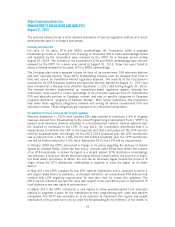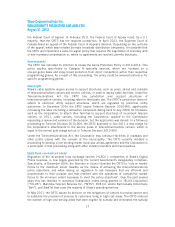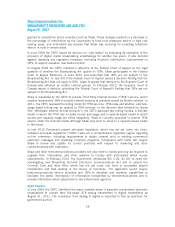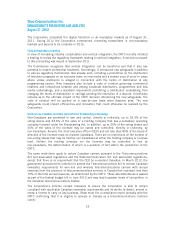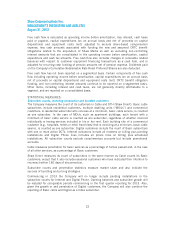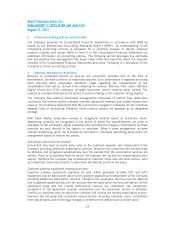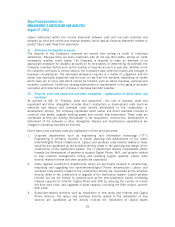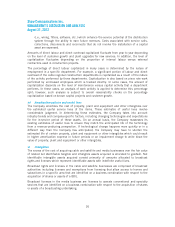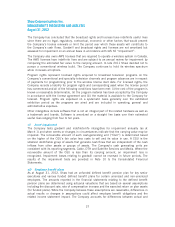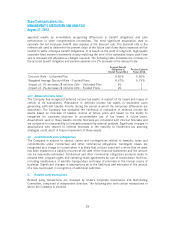Shaw 2012 Annual Report Download - page 22
Download and view the complete annual report
Please find page 22 of the 2012 Shaw annual report below. You can navigate through the pages in the report by either clicking on the pages listed below, or by using the keyword search tool below to find specific information within the annual report.Shaw Communications Inc.
MANAGEMENT’S DISCUSSION AND ANALYSIS
August 31, 2012
granted to competitive phone providers such as Shaw. These changes resulted in a decrease in
the percentage of contribution by the Corporation to fund local telephone service in high cost
serving areas, and eliminated any subsidy that Shaw was receiving for providing telephone
service in rural or remote areas.
In June 2009 the CRTC issued its decision on “new media” by extending its exemption of the
provision of digital media broadcasting undertakings for another five years. It also decided
against imposing any regulatory measures, including financial contribution requirements on
ISPs, to support Canadian new media content.
In August 2009 the CRTC initiated a reference to the Federal Court of Appeal on the legal
question of whether the Broadcasting Act applies to ISPs. Shaw participated in the Federal
Court of Appeal Reference in June 2010 and submitted that ISPs are not subject to the
Broadcasting Act. In July 2010 the Federal Court of Appeal issued a decision finding that the
Broadcasting Act does not apply to ISPs. Leave to appeal that decision to the Supreme Court of
Canada was obtained by certain cultural groups. In February 2012, the Supreme Court of
Canada issued a decision upholding the Federal Court of Appeal’s finding that ISPs are not
subject to the Broadcasting Act.
Shaw is mandated by the CRTC to provide Third Party Internet Access (“TPIA”) service, which
enables independent ISPs to provide Internet services at premises served by Shaw’s network. In
2011, the CRTC reviewed the billing model for TPIA services, TPIA rates and whether, and how,
usage based billing may be applied to TPIA services. In the decision that followed its review
(the “Wholesale Internet Access Decision”), the CRTC approved two billing models, a flat-rate
model in which the TPIA rate includes access and usage and a capacity-based model in which
access and capacity usage are billed separately. Shaw is currently approved to provide TPIA
service under the flat-rate model although Shaw may elect to move to a capacity-based model
in the future.
In late 2010 Parliament passed anti-spam legislation, which has not yet come into force.
Canada’s anti-spam legislation (“CASL”) sets out a comprehensive regulatory regime regarding
on-line commerce, including requirements to obtain consent prior to sending commercial
electronic messages and installing computer programs. Compliance with CASL will require
Shaw to review and update its current practices with respect to marketing and other
communications with customers.
Shaw and other telecommunications providers will also need to review and may be required to
upgrade their interception and other systems to comply with anticipated lawful access
requirements. In February 2012, the Government introduced Bill C-30, An Act to enact the
Investigating and Preventing Criminal Electronic Communications Act and to amend the
Criminal Code and other Acts, which has not yet come into force or proceeded beyond
introduction and first reading in the House of Commons. The legislation would require
telecommunications service providers and ISPs to establish and maintain capabilities to
facilitate the lawful interception of information transmitted by telecommunications and to
provide information about subscribers to law enforcement agencies.
Digital transition
In July 2009 the CRTC identified the major markets where it expected conventional television
broadcasters to convert their full-power OTA analog transmitters to digital transmitters by
August 31, 2011. The conversion from analog to digital is expected to free up spectrum for
government auction.
18


